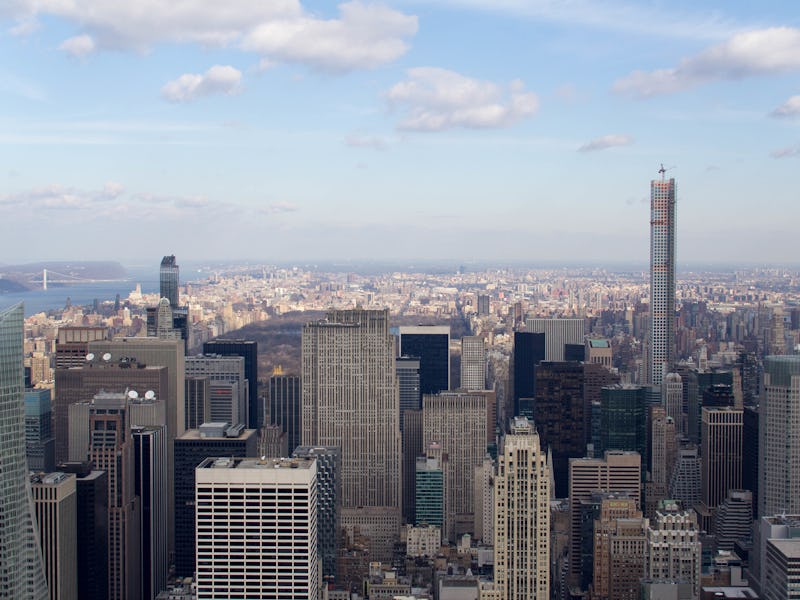Do Supertall Buildings Help or Hurt Cities?
The answer is, well, shadowy.

Today and Friday, ‘Inverse’ is covering the Municipal Art Society of New York’s sixth annual MAS Summit. More than 100 speakers and a thousand attendees are gathering over two days to discuss a wide range of issues affecting New York City, and brainstorming solutions that will help the Big Apple meet the needs of all New Yorkers in the five boroughs now and in the future.
New York City is defined by its skyscrapers. ‘Supertalls’ — as they are known in the urban design and planning community — turn our streets into valleys of glass and concrete. Aesthetically, it’s beautiful, but the results aren’t entirely visual or, for that matter, entirely predictable.
These days, the impact of supertalls are a big point of contention among urbanists — as underscored by a five-member panel Thursday morning at the MAS Summit. Are supertalls efficient enough? Do they block too much visibility and sunlight? Are the benefits outweighing the disadvantages? Should New York City take lessons from its West Coast rivals in San Francisco and impose height restrictions in certain neighborhoods? When you ask these questions to architecture, city planners, and property managers, you get very different responses.
When opening up the “When — and Where — Is A Supernal Worth It?” discussion, moderator Justin Davidson acutely summarized the feelings of many New Yorkers who “tend to think developers will put up the tallest tower that will make the most money… and not for the civic good.” High-rise design expert Chris Cooper, an architect at Skidmore, Owings & Merrill LLP, responded quickly by acknowledging the real presence of ethical questions when building supertalls, stating that urban planners had a responsibility to preserve visibility and existing sightlines.
But Cooper’s enthusiasm for supertalls was evident as he made the case for height. Adding more space on less land can “give us the vibrant, dense city that we all know and love,” he said, adding that “the towers define the skyline and city.” He believes detractors’ conflicts with supertalls might have less to do with height, and more to do with questions of quality and how supertalls affect the identity of the neighborhoods they loom over.
Layla Law-Gisiko is one of those detractors. The chair of the Central Park Sunshine Task Force of Manhattan Community Board Five, Law-Gisiko is heavily involved with trying to preserve the park’s ability to soak up the sunlight amidst an increasing number of supertalls in the vicinity. She assailed the decades-old NYC zoning code, which provides no mechanism by which to prevent supertalls from casting shadows that run hundreds of feet down the street and into nearby green spaces. “One building could obliterate the light,” she said. “We do not want to plunge all our open space into shadows.”
Still, Cooper found comrades in the other two panelists: Janno Lieber, the president of World Trade Center Properties; and Angela Pinsky, the executive director of the Association for a Better New York. Lieber pointed to how essential supertalls were to the identity of New York City and its businesses, as opposed to many other places in the U.S. that have chosen to build large corporate parks next to interstate highways. The ability of supertalls to accommodate and even encourage a dense urban environment wasn’t simply more sustainable — it was part of the “essence of New York.”
World Trade 1 in New York City.
Pinsky emphasized that supertalls are one of the few ways New York City can accommodate population growth — planned for or not. She argued that the city’s 44,000 new housing units comprise just a third of what is needed to accommodate the influx of new New Yorkers.
Although the overall tide suggests supertalls are here to stay, Law-Gisiko raised a very important issue — many supertalls lack the efficiencies that make them so appealing in the first place. Off 57th Street, for example, building heights are skyrocketed, yet the density of the community remains the same. Supertalls that don’t provide any sustainable benefit simply eat away at finite building resources that are shrinking every day.
East 57th Street in Manhattan.
As supertalls continue to be built, New York City certainly ought to take another look at its zoning codes. But Law-Gisiko and others shouldn’t expect New Yorkers to start adopting San Francisco-style regulations any time soon — especially when the Bay Area is grappling far worse with its own housing crisis than New York City.
As Lieber succinctly put it at the end of the discussion, “There’s a shift taking place that validates the value of new buildings.”